Curated Guides > Thematic Series > Seeing America
Seeing America
Created with 25 leading museums and cultural organizations, this series examines the long history of the United States from before European settlers to the modern era.
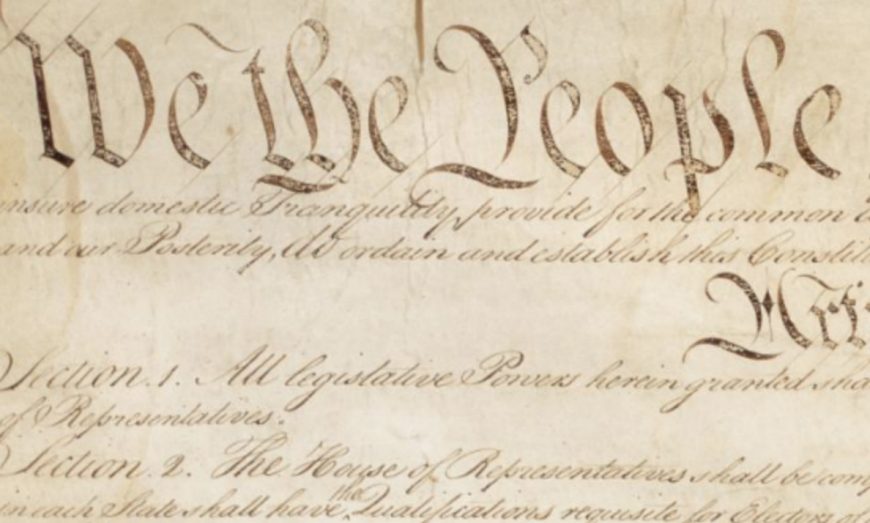
Constitution of the United States, 1787 (National Archives, Washington, D.C.)
Learn about Clovis culture, the beginnings of agriculture, large urban centers, and the arrival of Europeans.
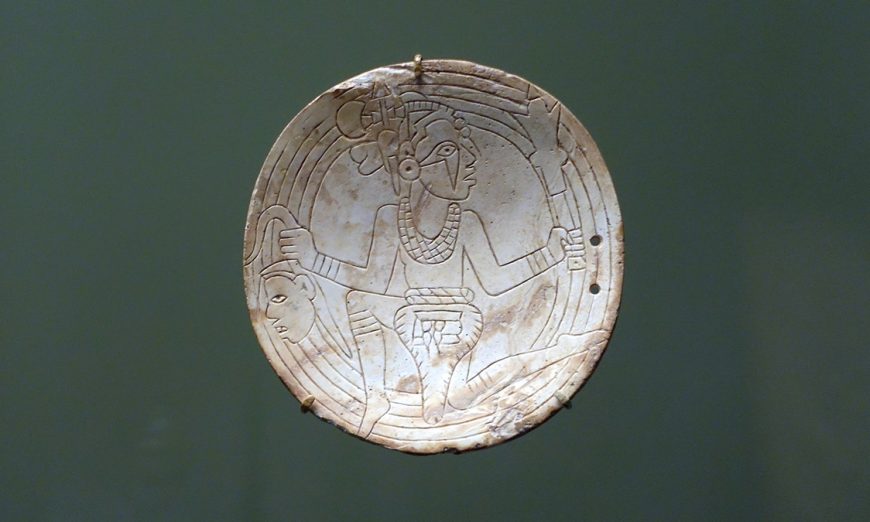
Gorget, c. 1250–1350 (probably Middle Mississippian Tradition), whelk shell, 10 x 2 cm (National Museum of the American Indian, Smithsonian Institution, Washington, D.C.)
- Before 1607 in North America, an introduction
- About geography and chronological periods in Native American art
- Clovis culture
- Introduction to Chaco Canyon
- Mesa Verde
- Mississippian shell neck ornament (gorget)
- Fort Ancient Culture: Great Serpent Mound
- Paquimé jars
- Taíno Kuisa
- Teaching Guides
- Teaching guide: Mississippian shell gorget
Migration within North America and competition over resources, boundaries, and trade intensified conflicts among peoples and nations.

Covered sugar bowl, c. 1745, silver, 11.5 x 9.1 cm (Wadsworth Atheneum Museum of Art)
- 1607–1754 in North America: colonies, slavery, and war
- Theodore de Bry, Grands Voyages from the Collected travels in the east Indies and west Indies
- Mission Church, San Esteban del Rey, Acoma Pueblo
- Puritan court cupboard
- Portraits of John and Elizabeth Freake (and their baby)
- James Wooldridge, Indians of Virginia
- Codex Canadensis
- Gerardus Duyckinck I (attributed), Six portraits of the Levy-Franks family, c. 1735
- The triangle trade and the colonial table, sugar, tea, and slavery
- Teaching Guides
- Teaching guide: Covered sugar bowl
- Teaching guide: Six Portraits of the Levy-Franks family
The American Revolutionary War, the Declaration of Independence, and the birth of the two-party system — this is a pivotal period in American history.
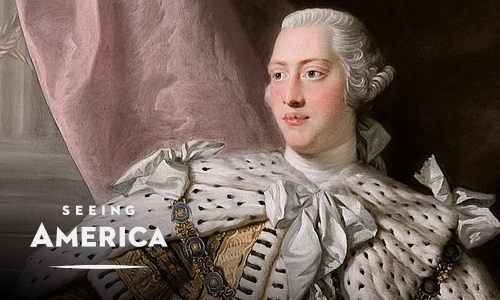
Allan Ramsay and studio, King George III in Coronation Robes, c.1765, oil on canvas, 236.2 x 158.7 cm (Art Gallery of South Australia)
- 1754–1800 in North America, an introduction
- Sir Joshua Reynolds, Portrait of Syacust Ukah
- John Singleton Copley, Paul Revere
- Benjamin West, The Death of General Wolfe
- Benjamin West, Penn’s Treaty with the Indians
- John Singleton Copley, Portrait of Mr. and Mrs. Thomas Mifflin (Sarah Morris)
- Thomas Jefferson, Monticello
- Francisco Clapera, set of sixteen casta paintings
- John Trumbull, The Declaration of Independence
- Jean-Antoine Houdon, George Washington
- Gilbert Stuart’s Lansdowne Portrait
- Global trade and an 18th-century Anishinaabe outfit
- Teaching Guides
- Teaching guide: Benjamin West, Penn’s Treaty with the Indians
- Teaching guide: Francisco Clapera, set of sixteen casta paintings
The new republic struggled to define and extend democratic ideals in the face of rapid economic, territorial, and demographic changes.
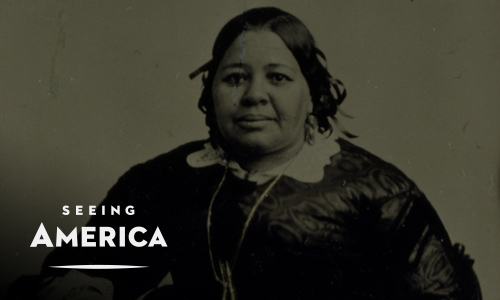
Albro Lyons, Sr. and Mary Joseph Lyons (detail of Mary Joseph Lyons), c. 1860, ambrotype (Schomburg Center for Research in Black Culture, New York Public Library)
- 1800–48 in the United States, an introduction
- Rembrandt Peale, Rubens Peale with a Geranium
- Thomas Birch, Perry’s Victory on Lake Erie
- Juana Basilia Sitmelelene, Presentation Basket (Chumash)
- An African Muslim among the founding fathers, Charles Willson Peale’s Yarrow Mamout
- Francis Guy, Winter Scene in Brooklyn
- Thomas Birch, Fairmount Water Works
- Hicks’s The Peaceable Kingdom as Pennsylvania parable
- John Wesley Jarvis, Black Hawk and His Son Whirling Thunder
- William Sidney Mount, Bargaining for a Horse
- Thomas Cole, The Oxbow
- Thomas Cole, The Architect’s Dream
- Slave Burial Ground, University of Alabama
- Hiram Powers, The Greek Slave
- Thomas Cole, The Voyage of Life
- George Catlin, The White Cloud, Head Chief of the Iowas
- Thomas Cole, The Hunter’s Return
- John James Audubon, The Wild Turkey
- The Mexican-American War
- Richard Caton Woodville, War News from Mexico
- Seneca Village: the lost history of African Americans in New York
- Teaching Guides
- Teaching guide: Thomas Cole, The Hunter’s Return
- Teaching guide: Thomas Birch, Perry’s Victory on Lake Erie
- Teaching guide: Hicks, The Peaceable Kingdom
The United States extended its territories, fought a civil war, and violently persecuted African and Native Americans.
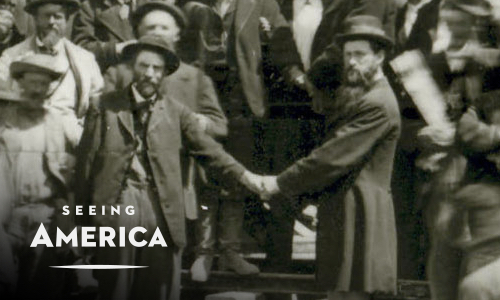
Andrew J. Russell, Joining of the rails at Promontory Point, May 10, 1869
- 1848–77 in the United States, an introduction
- Bandolier Bag
- Asher B. Durand, Kindred Spirits
- Inventing America, Colt’s Experimental Pocket Pistol
- George Caleb Bingham, Country Politician
- Emanuel Leutze, Washington Crossing the Delaware
- Peter Frederick Rothermel, De Soto Raising the Cross on the Banks of the Mississippi
- Frederic Church, The Natural Bridge, Virginia
- Nativism, immigration, and the Know-Nothing party
- George Inness, The Lackawanna Valley
- Jasper Francis Cropsey, Mount Jefferson, Pinkham Notch, White Mountains
- Thomas Crawford, George Washington Equestrian Monument
- David Gilmour Blythe, Justice
- Emanuel Gottlieb Leutze, Westward the Course of Empire Takes Its Way
- Eastman Johnson, A Ride for Liberty — The Fugitive Slaves
- Science, religion, and politics, Church’s Cotopaxi
- Little Round House
- John Quincy Adams Ward, The Freedman
- Anna Pottery, Snake jug
- Carleton Watkins, Eagle Creek, Columbia River
- Lilly Martin Spencer, The Home of the Red, White, and Blue
- Samuel Colman, Jr., Ships Unloading, New York
- Olmsted and Vaux, Central Park
- Bear Claw Necklace (Pawnee)
- Thomas Moran, Grand Canyon of the Yellowstone
- Edmonia Lewis, The Old Arrow Maker
- Albert Bierstadt, Hetch Hetchy Valley, California
- James Abbott McNeill Whistler, Nocturne in Black and Gold: The Falling Rocket
- Winslow Homer, Taking Sunflower to Teacher
- Frederic Edwin Church, The Iceberg
- Thomas Eakins, The Gross Clinic and The Agnew Clinic
- Tlingit mortuary and memorial totem poles
- Haida Totem Pole, from Old Kasaan
- Haida potlatch pole
- Bentwood Boxes of the Northwest Coast peoples
- Paukeigope (Kiowa), Cradleboard
- Teaching Guides
- Teaching guide: Thomas Moran, Grand Canyon of the Yellowstone
- Teaching guide: Eastman Johnson, A Ride for Liberty — The Fugitive Slaves
A period of technological progress, growing wealth, and social activism, the Gilded Age was also an era of widespread inequality and injustice.

Detail, Henry Ossawa Tanner, The Banjo Lesson, 1893, oil on canvas, 49 × 35.5 inches / 124.5 × 90.2 cm (Hampton University Museum, Hampton, VA)
- 1877–1898 in the United States, an introduction
- Nellie Two Bear Gates, Suitcase
- The story of the Oyster Man, a Tlingit totem pole
- Proud Raven totem pole at Saxman Totem Park
- The New York Obelisk, Cleopatra’s Needle
- Thomas Hovenden, The Last Moments of John Brown
- Robert Mills and Lieutenant Colonel Thomas Lincoln Casey, Washington Monument
- Burnham and Root, The Monadnock Building
- The light of democracy — examining the Statue of Liberty
- Grafton Tyler Brown, View of the Lower Falls, Grand Canyon of the Yellowstone
- Francisco Oller, Still Life with Plantains and Bananas and Still Life with Coconuts
- Jacob Riis, “Knee-Pants” at Forty-Five Cents a Dozen—A Ludlow Street Sweater’s Shop, from How the Other Half Lives
- William F. Cogswell, Queen Lili’uokalani, and Maria Kealaulaokalani Lane Ena, ʻAhu ʻula (The Kalākaua Cape)
- Childe Hassam, Horticulture Building, World’s Columbian Exposition, Chicago
- Henry Ossawa Tanner, The Banjo Lesson
- Henry Ossawa Tanner, The Thankful Poor
- Frederic Remington, The Fall of the Cowboy
- Burnham and Root, Reliance Building
- Soaring upward, Louis Sullivan and the invention of the skyscraper
- Teaching Guides
- Teaching guide: Saxman Totem Park and the New Deal in Alaska
- Teaching guide: Thomas Hovenden, The Last Moments of John Brown
Technological advances, large-scale production methods, and the opening of new markets encouraged the rise of industrial capitalism in the United States.
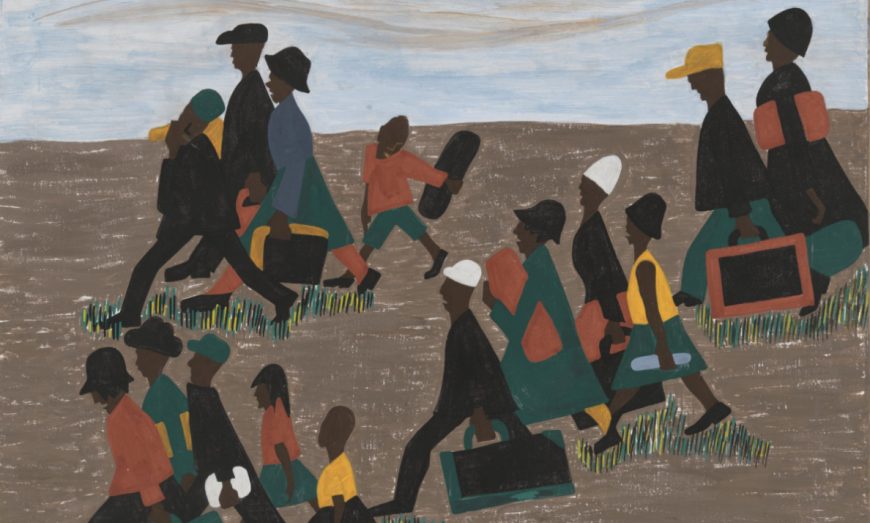
Jacob Lawrence, The Migration Series, 1940–41, 60 panels, tempera on hardboard (even numbers at The Museum of Modern Art, New York, odd numbers at the Phillips Collection, Washington D.C.)
- 1898–1945 in the United States, an introduction
- Monument Avenue and the Lost Cause
- Manuel Cuyàs Agulló, El desembarque de los americanos en Ponce, 27 de julio de 1898
- Francisco Oller y Cestero, President William McKinley
- Henry Oscar One Bull, Custer’s War
- Shrady and Casey, Ulysses S. Grant Memorial
- Winslow Homer, Searchlight on Harbor Entrance, Santiago de Cuba
- Armando García Menocal, Campesino y soldado español (Peasant and Spanish soldier)
- Willard Metcalf, Havana Harbor
- The Chief Johnson Totem Pole
- Louis Sullivan, Carson, Pirie, Scott Building
- American brilliance at the St. Louis World’s Fair: Libbey’s Punch Bowl
- George Benjamin Luks, Street Scene (Hester Street)
- Alfred Stieglitz, The Steerage
- George Bellows, Pennsylvania Station Excavation
- George Bellows, Both Members of This Club
- North Wind Mask
- When the department store was new: Elizabeth Sparhawk-Jones, The Shoe Shop
- John Sloan, Movies
- Jonas Lie, The Conquerors (Culebra Cut, Panama Canal)
- Stone Mountain, Georgia
- Childe Hassam, Allies Day, May 1917
- Henry Ossawa Tanner, The Good Shepherd
- George Bellows, Return of the Useless
- Walter Ufer, Hunger
- The City at night, Joseph Stella’s The Voice of the City of New York Interpreted
- Frederick MacMonnies, Civic Virtue
- Yasuo Kuniyoshi, Little Joe with Cow
- The lure of the American Southwest: E. Martin Hennings, Rabbit Hunt
- Elsie Driggs, Blast Furnaces
- Georgia O’Keeffe, Radiator Building—Night, New York
- Connecticut Klan robe
- Todros Geller, Strange Worlds
- Florine Stettheimer, Portrait of Alfred Stieglitz
- Nampeyo (Hopi-Tewa), polychrome jar
- The pueblo modernism of Ma Pe Wi
- Grant Wood, American Gothic
- William Van Alen, The Chrysler Building
- Diego Rivera’s Sugar Cane
- Ben Shahn, The Passion of Sacco and Vanzetti
- Stephen Mopope, Game of Skill
- Millard Sheets, Tenement Flats
- Diego Rivera, Man Controller of the Universe
- Frank Lloyd Wright, Fallingwater
- Reginald Marsh, Wooden Horses
- Aaron Douglas, Aspiration
- Dorothea Lange, Migrant Mother
- George Grosz, Remembering
- Glass Chair at the 1939 New York World’s Fair
- Grant Wood, Parson Weems’ Fable
- Russel Wright, “American Modern” Pitchers
- Alexandre Hogue, Crucified Land
- Rosa Rolanda, Self-Portrait
- Ben Shahn, Contemporary American Sculpture
- Jacob Lawrence, The Migration Series
- Eldzier Cortor, Southern Landscape
- Romare Bearden, Factory Workers
- Rufino Tamayo, Perro aullando a la luna (Dog Howling at the Moon)
- Horace Pippin, Mr. Prejudice
- Norman Rockwell, Rosie the Riveter
- Horace Pippin, Holy Mountain, I
- Teaching Guides
- Teaching guide: The City Beautiful Movement
- Teaching guide: Aaron Douglas, Aspiration
- Teaching guide: Horace Pippin, Mr. Prejudice
- Teaching guide: Norman Rockwell, Rosie the Riveter
The era of Disneyland and the Moon landing was also a time of war, social activism, and the making of the American Dream.
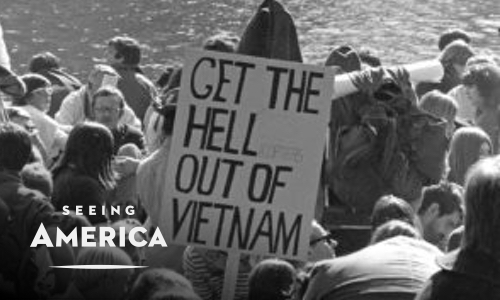
Anti-war protestors, 1967 (Lyndon B. Johnson Library and Museum)
- 1945–80 in the United States, an introduction
- Charles Sebree, The Mystic
- Edward Hopper, Nighthawks
- Norman Lewis, Untitled
- Norman Lewis, Untitled (Subway Station)
- Vertis Hayes, Juke Joint
- Gordon Parks, Off on My Own (Harlem, New York)
- Ben Shahn, Miners’ Wives
- A Harlem street scene by Jacob Lawrence, Ambulance Call
- Thelma Johnson Streat, Girl with Bird
- Rafael Tufiño, La Plena
- George Tooker, Highway
- Rafael Tufiño, Goyita
- Sari Dienes, Star Circle
- Jasper Johns, Flag
- Frank Lloyd Wright, Bachman-Wilson House
- Ludwig Mies van der Rohe, Seagram Building, New York City
- Hedda Sterne, Number 3—1957
- Ruth Asawa, Untitled
- Garry Winogrand, Democratic National Convention, Los Angeles, 1960
- Mark Rothko, No. 210/No. 211 (Orange), 1960
- Benny Andrews, Flag Day
- Jess, If All the World Were Paper and All the Water Sink
- Andy Warhol, Coca-Cola [3]
- Homage to JFK: Rauschenberg’s Retroactive I
- A Landmark Decision: Penn Station, Grand Central, and the architectural heritage of NYC
- Beauford Delaney, Marian Anderson
- Marisol, The Party
- Romare Bearden, Three Folk Musicians
- Brummett Echohawk, An Island of Redbuds on the Cimarron
- Alma Thomas, Lunar Rendezvous—Circle of Flowers
- Claes Oldenburg, Lipstick (Ascending) on Caterpillar Tracks
- Robert Smithson, Spiral Jetty
- Marcos Dimas, Lolita Lebrón: Puerto Rican Freedom Fighter
- Duane Hanson, Executive, originally titled, Another Day
- Mel Casas, Humanscape 70 (Comic Whitewash)
- Mierle Laderman Ukeles, Washing/Tracks/Maintenance: Outside (July 23, 1973)
- Alice Aycock, Low Building with Dirt Roof (For Mary)
- Faith Ringgold, Ben
- Sam Gilliam, Purpled (Chasers Series)
- Maya Lin, Vietnam Veterans Memorial
- Harry Fonseca, Two Coyotes with Flags
- Teaching Guides
- Teaching guide: Spiral—Black Art and the Civil Rights Movement
- Teaching guide: Benny Andrews, Flag Day
Revolutionary technologies hasten a new era of interconnectivity, mass culture, and globalization, while new wars and concerns about the climate, the environment, and rights to privacy emerge.
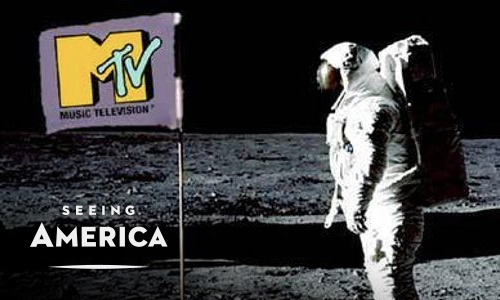
MTV's moonman, first broadcast 1981
- 1980–now in the United States, an introduction
- Ruthe Blalock Jones, Medicine Woman
- Arpilleras
- Jenny Holzer, Inflammatory Essays and All Fall
- Roger Minick, Woman with Scarf at Inspiration Point, Yosemite National Park
- Superman, World War II, and Japanese-American experience
- Masami Teraoka, American Kabuki
- Jamie Wyeth, Kalounna in Frogtown
- Toshiko Takaezu, Crater Moon
- Carrie Mae Weems, Untitled (Woman Feeding Bird), from The Kitchen Table Series
- Sue Coe, Aids won’t wait, the enemy is here not in Kuwait
- Felix Gonzalez-Torres, “Untitled” (L.A.)
- Sebastião Salgado’s Kuwait
- Richard Serra, Tilted Arc
- Thornton Dial, Blood and Meat: Survival For The World
- Jaune Quick-to-See Smith, Trade (Gifts for Trading Land with White People)
- Richard Mayhew, Indigenous Spiritual Space
- Pepón Osorio, En la barbería no se llora (No Crying Allowed in the Barbershop)
- Nam June Paik, Electronic Superhighway: Continental U.S., Alaska, Hawaii
- Kerry James Marshall, Our Town
- Stefanie Jackson, Bluest Eye
- What’s in a map? Jaune Quick-to-See Smith’s State Names
- Stéphane Couturier, Fenetre, Eastlake Greens, San Diego
- Wayne Thiebaud, Ponds and Streams
- Richard Prince, Nurse Elsa
- Luis Alfonso Jiménez, Eagle
- James Turrell, Skyspace, the way of color
- Barbara Zucker, Time Signatures: Homage to Linda and Lucy. My Luminaries
- Contemporary politics and classical architecture
- History and deception: Kenseth Armstead’s Surrender Yorktown 1781
- Wendy Red Star, 1880 Crow Peace Delegation
- Clarissa Rizal, Resilience Robe
- Maya Lin’s Silver Upper White River
- Nari Ward, We the People (black version)
- Courtney Leonard, ARTIFICE Ellipse, 2016
- Titus Kaphar, The Cost of Removal
- Turning Uncle Tom’s Cabin upside down, Alison Saar’s Topsy
- Dorica Jackson, Diving Whale Chilkat Robe
- Hock E Aye Vi Edgar Heap of Birds, Native Hosts (Arkansas)
- Glenn Ligon, Untitled (America)
- The National Memorial for Peace and Justice (Equal Justice Initiative)
- Kehinde Wiley, Rumors of War
- Amy Sherald, Precious Jewels by the Sea
- Firelei Báez, Untitled (A Correct Chart of Hispaniola with the Windward Passage)
- Rashid Johnson, Stacked Heads
- Richard Zane Smith, Wyandotte Feast Pot
- Marilyn Spoon, Bandolier Bag
- Maya Lin, Ghost Forest
- Mickalene Thomas, Guernica (Resist #3)
- Genesis Báez, Crossing Time
- Glendalys Medina, Atabey
- Beatriz Cortez, Ilopango, The Volcano That Left
- Kerry James Marshall, Now And Forever; Elizabeth Alexander, “American Song,” Washington National Cathedral
- Martin Puryear, Lookout
- Ilana Savdie, Thirty-Seven Counts and Trismus
- Teaching Guides
- Teaching guide: Titus Kaphar, The Cost of Removal
- Teaching guide: Wayne Thiebaud, Ponds and Streams
- Teaching guide: Jaune Quick-To-See Smith, State Names

 Open All
Open All Collapse All
Collapse All